History of rugby union in the United States
The first recorded rugby match in the United States occurred on May 14, 1874 between Harvard University and McGill University. Rugby grew in the early 1900s, spurred in party by American football's crisis of 1905-06 due to the perception that American football was a violent sport.[1] During this era, rugby was perceived as having the potential to challenge American football as the dominant football code on the west coast.[1] At the 1920 Summer Olympics in Antwerp, a United States rugby team composed largely of players from Stanford University defeated France to win the gold medal.[2] Rugby union was again included in the 1924 Summer Olympics in Paris, where the United States defeated France for the gold. Despite this success, however, rugby in the United States largely faded away.
Rugby union in the United States began its revival in the 1960s and 1970s, as many colleges started club rugby teams.[3] USA Rugby, the body that governs rugby in the U.S., was founded in 1975. On 31 January 1976, the U.S. national team played Australia—in its first official match since the 1924 Olympics—before 7,000 fans at Glover Field in Los Angeles.[4] The United States national team participated in the inaugural 1987 Rugby World Cup. Rugby in the U.S. received a significant boost in 2009 when the International Olympic Committee voted to reinstate rugby into the Summer Olympics beginning in 2016.
Professional competition of rugby union began in 2017, and the currently-sanctioned top-level professional league, Major League Rugby began play in 2018.
Early football variants
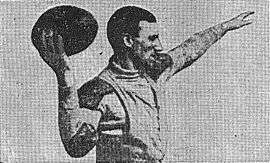
Early European settlers in North America brought forms of medieval and traditional football with them. However, we know that in 1610, William Strachey, an English colonist at Jamestown, Virginia recorded a game played by Native Americans, called Pahsaheman, so it is clear that they had their own codes as well.[6] Early games appear to have had much in common with the traditional "mob football" played in England. The games remained largely unorganized until the 19th century, when intramural games of football began to be played on college campuses. Each school played its own variety of football.
Princeton students played a game called "ballown" as early as 1820. A Harvard tradition known as "Bloody Monday" began in 1827, which consisted of a mass ballgame between the freshman and sophomore classes. Dartmouth played its own version called "Old division football", the rules of which were first published in 1871, though the game dates to at least the 1830s. All of these games, and others, shared certain commonalities. They remained largely "mob" style games, with huge numbers of players attempting to advance the ball into a goal area, often by any means necessary. Rules were simple and violence and injury were common.[7][8] The violence of these mob-style games led to widespread protests and a decision to abandon them. Yale, under pressure from the city of New Haven, banned the play of all forms of football in 1860, while Harvard followed suit in 1861.[7]
Early U.S. rugby history: 1800s
The sport of rugby union in the United States has always had a close relationship with the sport of American football. Initially, games of rugby, soccer, and hybrid games had been played between American universities. Primitive forms of rugby, then all covered by the name "football", were being played in the USA as far back as the 1840s, at Harvard, Yale and Princeton, stemming partly from Americans who had been educated in English schools.[9] However, in 1862, Yale dealt it a major blow by banning it for being too violent and dangerous, about seven years later, in 1869, the first game of College football was played between Princeton and Rutgers.[9] However, rugby was taking a firm grip of the Ivy League and other East Coast Universities, where it would have an influence on the nascent gridiron, which later became its major competitor.[9] Unfortunately American football's growth came at exactly the point at which rugby was beginning to establish itself in the States.[9] Rugby spread through America's colleges, away from the Ivy League and the East Coast, into Texas, California and other west coast states.[9] However, because of America's huge size, this resulted in a bipolar game, played mainly in east and west, but not really in the middle – other than Illinois and the Great Lakes, and Texas in the south.[9] There would also come to be a small rugby playing centre in Salt Lake City, as Polynesian Mormons came to study and live there, and to a lesser extent by returning missionaries.[9]
In 1872, rugby clubs were established in the San Francisco Bay Area, composed mainly of British expatriates.
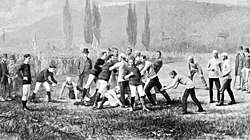
The first recorded rugby match in the United States occurred on May 14, 1874 between Harvard University and McGill University.
In 1876, Yale, Harvard, Princeton, and Columbia formed the Intercollegiate Football Association, a competition based on the traditional rules of rugby union. Around the same time, the aforementioned British rugby players of San Francisco introduced rugby to the University of California, Berkeley.
A persistent problem within rugby football would be the question of amateurism vs professionalism. American football would take the professional route, something much frowned upon by the leadership of the rugby fraternity at the time. This was leading to crises in the Old World too, where in 1895, the Northern Rugby Football Union (a rugby league body) split away in England. While rugby league failed to gain much headway in North America, the financial draw of professional American football proved too strong for some American rugby players. Rugby union would not become professional officially until the 1990s.
Rugby and American football
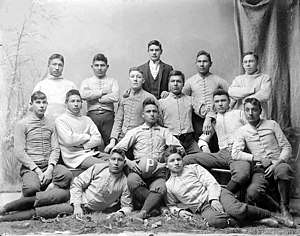
Rugby has had a long and complicated relationship with American football. William Gunmere of Rutgers devised the game, and based it upon American forms of rugby and association football.[9] Another important point is that during the 19th century, the United States was trying to develop a new national culture, independent of its English colonial roots, as it had become politically independent the previous century. This extended into the sporting arena, with the adoption and invention of American football and basketball, and also the myth of Abner Doubleday founding baseball, which attempted to divorce it from its English origins.
Unlike football, rugby has established itself through the United States via its colleges and universities.[9]
By the end of the 19th century, rugby's American offspring had outgrown its parent within America, and many young Americans who would have made good rugby players were steered into American football instead.
Nonetheless, some of rugby's legacy can be seen in American football to this day, including its prolate spheroid football, rucking, and elevated goalposts of similar width. Major differences include higher tackles than rugby, protective equipment, and forward passing. The fair catch kick is a relic of the now obsolete goal from mark. The scoring systems have evolved in parallel, with both rugby union and American football offering three points for a kicked goal and seven points for a ball run into the end zone and a successfully kicked conversion.
Early 1900s
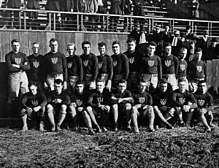
One factor aiding in rugby's growth in the early 1900s was American football's crisis of 1905–06, with President Teddy Roosevelt engaging in a debate about the future of American football in response to the perception that American football was a violent sport.[1]
The growth of rugby in the United States and particularly in California was aided by the 1905 New Zealand national team, known as The Originals, playing three matches in the U.S. in early 1906 —one exhibition match in New York, and two exhibition matches in California against teams from British Columbia.[2][9] Apart from the high standard of rugby in various parts of Canada, it was not uncommon for Australian and New Zealand sides to play games in the USA – especially California and New York – when returning from Europe, or when European teams made the trip the other way.[9]
Some west coast colleges—including the flagship University of California, Stanford University, and Santa Clara—abandoned their American football programs in favor of rugby.[1] The "Big Game" American football rivalry between Cal and Stanford was played as a rugby match instead of American football from 1906 to 1914 (1906 was notable for being the first year that American football had legalized the forward pass, a system that would become a distinguishing characteristic in the American game that is not present in rugby).[10] [11]

Rugby union grew on the West Coast, and as many as 26,000 spectators regularly attended matches between the University of California and Stanford University.[12] During this era, rugby was perceived as having the potential to challenge American football as the dominant football code on the west coast.[1]
The unfamiliar and complex game play hampered rugby's initial growth on the East Coast. Controversy arose in 1905 when published photographs of a rugby match between Swarthmore College and the University of Pennsylvania were used to depict rugby as a "harsh game".
In 1908 and 1909, the Australian national team visited the U.S. as part of an international tour, playing university teams and an all-California side.
In 1910, a combined Universities rugby team comprising mostly players from Cal, Stanford, and the University of Nevada went on a tour of Australia and New Zealand. The underdog American side upset both Rotorua RFC and Auckland RU, which came as a great surprise to the international rugby community. In 1910, D.W. Wheeler of the University of California wrote that "rugby throughout the state is on the boom," with five out of six San Francisco high schools having taken up rugby.[13]

In 1912, the Australian national team returned to America; this tour was the first and only America-specific tour by Australia to date. Stanford University defeated the Australian national team 13–12 on 16 October 1912, with the San Francisco Examiner declaring that the win had "raised America to a position among the first-class rugby nations."[2] Australia's 1912 tour of the United States saw the United States national team play their first international test against Australia.[14] The United States performed well, holding a lead in the second half, before losing 12–8.[1] The San Francisco Chronicle declared that "America has arrived on the international map" and predicted that the U.S. "will be looking down upon all the other nations in a few more years."[1]
After a promising start on the international stage, the Americans were thrashed 51–3 a year later by a strong All Blacks side in their tour on North America. This test was organized by former Cal president Benjamin Ide Wheeler in an attempt to popularize rugby among his students.
By 1915, rugby in California was already beginning to decline.[2] The University of California returned to American football in 1915-1916.[1] Once the University of California returned to American football, a number of local schools quickly followed.[2]
The vastness of the USA has resulted in the rise of regional "Conferences", where the East and West played as different blocs.[9] Hawaii and Alaska led completely separate rugby existences, focusing their energy on their South Seas, and British Columbian neighbors instead.[9] Until recently this vastness also caused problems in the preparation of a national team, as the players would rarely get to meet one another.[9]
Olympics gold: 1920 & 1924
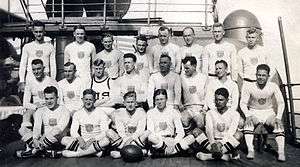
The U.S. national team won their first test in 1919, defeating Romania.
Rugby union was a fixture at the 1920 Summer Olympics in Antwerp, and a United States team composed largely of players from Stanford University and coached by Dan Carroll defeated France to win the gold medal, after money was raised in San Francisco to send them to Europe.[2]
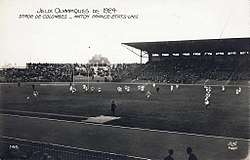
In 1924, rugby union was again included in the 1924 Summer Olympics in Paris. An American side was invited to participate, and the team surprised spectators by landing a place in the final with the hosts – the French. An estimated 50,000 turned up to Colombes Stadium to watch. The United States defeated France for the gold in 1924.
This was, however, the last time until 2016 when rugby featured at the Olympics, and the last ever for the full 15-man version of the game (the return of rugby in 2016 was in the sevens version). As a result, the 1924 United States team is the last to win gold in the full version of rugby union. Rare vintage footage of the 1924 Gold Medal match was included in the rugby documentary, A Giant Awakens: the Rise of American Rugby.
1930s-1950s: Attempted introduction of rugby league
In the mid twentieth century, rugby union continued to be a purely amateur sport, unlike American football and the breakaway rugby league. Rugby league didn't make much headway in the USA, for the simple reason that many rugby players who wished to go professional could go into gridiron instead where there was better pay. The expansion of rugby league was frequently at the expense of rugby union elsewhere.
An early attempt to introduce rugby league was in 1939, when the Californian Rugby Football Union wrote to the governing body of rugby league, the Rugby Football League, to tell them they wanted to switch from rugby union and affiliate to the RFL. The timing was unfortunate, and the RFL was unable to send out a delegation due to the outbreak of the outbreak of World War II in Europe. California was one of the historic heartlands of rugby union in the USA.
However, during the war itself, American servicemen stationed abroad occasionally played matches against teams from other allied sides - these included those from the British, Australian and South African militaries.
Another, post-war attempt to introduce rugby league to the USA took place in 1953, when wrestling promoter, Mike Dimitro was asked to organize a tour of Australasia by an American rugby league team. However, this failed to generate much interest, and none of the team had ever played rugby league before the tour. Dimitrio did persist though, by holding exhibition games by the Australian and New Zealand rugby league teams, again in California. Dimitrio later tried to get a rugby league world cup in the USA, but this also failed, and the rugby played in the USA remained mainly of the union variety.
It was not until the late 1970s that any more serious attempts were made to introduce rugby league.
Modern history: 1960s–present
Rugby began its revival in the United States in the late 1950s and into the 1960s and 1970s, as many colleges started club rugby teams. Rugby began getting some coverage in the media, including in the New York Times, when 1958 Heisman Trophy winner Pete Dawkins played for Oxford against Cambridge in 1959.[3] The first rugby sevens tournament in the U.S. was played during Thanksgiving weekend in 1959 in New York with eight teams from various northeast colleges.[3]
USA Rugby, the body that governs rugby in the U.S., was founded in 1975. On 31 January 1976, the U.S. national team played Australia—in its first official match since the 1924 Olympics—before 7,000 fans at Glover Field in Los Angeles. In 1980, USA Rugby formed a college national championship tournament. In 1987, the U.S. national team participated in the inaugural Rugby World Cup. The U.S. women's national team was officially formed in 1987. The Rugby Super League, a nationwide club competition, was played from 1996 to 2012. From 2003 to 2011, the U.S. national team played in the Churchill Cup, with the U.S. hosting matches from 2006 to 2010. The U.S. men's national rugby sevens team has participated in the World Rugby Sevens Series each year since the tournament's founding in 1999, and the women's national sevens team has participated in the World Rugby Women's Sevens Series since the competition's launch in 2012. Rugby in the U.S. received a significant boost in 2009 when the International Olympic Committee voted to reinstate rugby into the Summer Olympics beginning in 2016. In 2014, the United States hosted the New Zealand national team before a record sellout crowd of 60,000+ at Soldier Field in Chicago, a match later billed as potentially marking the rise of American rugby.[15] In 2016, PRO Rugby established the first fully professional Rugby competition in the U.S. Also in that year, the English top-flight club London Irish took a home match against Saracens to the Red Bull Arena in the New York area, marking the first top-flight English match ever held outside that country.
Professionalization
During the 1990s, rugby union became officially professional on a global level. In early November 2015, a new professional rugby organization, named PRO Rugby, launched its Facebook page and scheduled an announcement for November 9, 2015.[16] On November 9, 2015, PRO Rugby made an official announcement outlining its plans and a framework for the competition. USA Rugby affirmed that it sanctioned and supported the PRO Rugby competition.[17] Despite a 2016 PRO Rugby season being held, issues occurred during the offseason, and a second season never occurred.
PRO Rugby folded the San Francisco Rush in December 2016, citing a lack of a suitable venue, and on lack of support from the local media.[18] All PRO Rugby players then received notice on December 20, 2016, that their contracts would be terminated in 30 days if progress was not made towards resolving disputes between the league and USA Rugby. As of 2018, numerous players still report to have not been paid the salaries specified in their contracts with PRO Rugby. To recover some of their lost income, some players have elected to file claims with their local labor commissioner offices.[19] No other official announcements were made. By the end of 2017, no representative for PRO Rugby had shown up in any of the court cases in regards to the expenses owed to former director Lewis and others from the operation on the lone Pro Rugby season.[20]
Meanwhile, organization of what would become Major League Rugby began in September 2016. At least five amateur rugby union clubs across the United States began discussing a possible professional league, as Dean Howes, who had previously been an executive with Major League Soccer's Real Salt Lake and the St. Louis Blues of the National Hockey League, stepped in as senior strategic advisor for Rugby Utah in an attempt to provide a pathway for expanding professional rugby stateside.[21]
With PRO Rugby on its way to folding, by February 2017, a total of nine amateur rugby union organizations including the Austin Huns, Dallas Griffins, Glendale Raptors, Houston Strikers, Kansas City Blues, Minneapolis, New Orleans RFC, Rugby Utah and the Seattle Saracens, had announced their intentions to form a professional league to begin play the following year.[22][23]
On November 6, 2017, Major League Rugby and CBS Sports Network announced a multi-year television partnership which marked MLR's first major television deal for broadcast rights.[24] It was the first time in American history that a new sporting league had a national television deal prior to launch.[25]
The first regular season game in Major League Rugby history was held on April 21, 2018, when the Houston SaberCats hosted the New Orleans Gold in Houston. The Toronto Arrows joined the league ahead of 2019 season as the first Canadian team in MLR. Three further American clubs are set to begin play in 2020.[26]
See also
References
- "Rewind to the All Blacks tour of 1913: The tour that killed American rugby | Live Rugby Rewind to". ESPN Scrum. Retrieved 2016-10-25.
- "Brawn against Brains: Australia, New Zealand and the American 'football crisis', 1906-13" (PDF). Library.la84.org. May 2004. Retrieved 2016-10-25.
- "The Beginning of 7s in the US" Archived April 18, 2016, at the Wayback Machine, Rugby Today, August 11, 2014.
- "Australia Tour - Los Angeles, 31 January 1976". espn.co.uk. ESPN. Retrieved July 16, 2018.
- Cochems, Eddie, "The Forward Pass and On-Side Kick", Spalding's How to Play Foot Ball, American Sports Publishing, Walter Camp, Editor, Revised 1907 edition
- Pfister, Gertrud (2009). Understanding American Sport: In culture and society. Taylor & Francis. p. 38.
- "No Christian End!". The Journey to Camp: The Origins of American Football to 1769. Professional Football Researchers Association. Archived from the original on 2007-04-04. Retrieved 2007-05-16.
- Meacham, Scott. "Old Division Football, The Indigenous Mob Soccer Of Dartmouth College (pdf)" (PDF). Dartmo.com. Retrieved 2007-05-16.
- Bath, p.77
- "Many changes in rugby game". The Evening News (San Jose). September 14, 1906. Retrieved November 10, 2010.
- Elliott, Orrin Leslie (1937). Stanford University – The First Twenty Five Years 1891–1925. Stanford, California: Stanford University Press. pp. 231–233. Retrieved November 10, 2010.
- Rugby union - United States highest attendance on ESPN.com
- "Papers Past | Newspapers | Auckland Star | 8 October 1910". Paperspast.natlib.govt.nz. 1910-10-08. Retrieved 2016-10-25.
- USA v Australia has history by Alex Goff on Goff Rugby Report.com, 9 Apr 2015
- "Monday Maul: The highlights of the 2014-15 rugby season" Archived January 15, 2016, at the Wayback Machine, ESPN, Tom Hamilton, 1 June 2015.
- "Pro Rugby Announcement Coming Next Week", Goff Rugby Report, November 4, 2015.
- "PRO Rugby Launches First Professional League in North America", USA Rugby, November 9, 2015.
- "PRO RUGBY NIXES SAN FRANCISCO RUSH". Rugby Today. December 15, 2016.
- Clifton, Pat (2016-12-22). "Down Goes PRO". Rugby Today. Retrieved 2017-03-05.
- "Pro Rugby No-Show At Hearings". Flo Rugby. December 8, 2017.
- "Dean Howes, Former Real Salt Lake CEO, Joins Rugby Utah" (Press release). Utah Rugby. August 24, 2016. Retrieved May 30, 2019.
- "Major League Rugby Coming in 2018". Americas Rugby News. February 13, 2017. Retrieved May 30, 2019.
- "Nine Teams Confirmed for Major League Rugby". Americas Rugby News. May 5, 2017. Retrieved May 30, 2019.
- Bristol, Jason (November 13, 2017). "Houston, rugby has landed; to be broadcast on CBS Sports Network". KHOU-TV. Retrieved May 30, 2019.
- Hamilton, Tom (April 20, 2018). "Major League Rugby: Inside rugby's latest attempt to crack America". ESPN. Retrieved May 30, 2019.
- "Major League Rugby adds Ontario Arrows for 2019". Americas Rugby News. 2018-09-25. Archived from the original on 2018-09-25. Retrieved 2018-09-25.